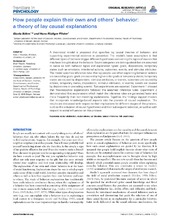| dc.contributor.author | Böhm, Gisela | |
| dc.contributor.author | Pfister, Hans-Rudiger | |
| dc.date.accessioned | 2016-01-29T08:14:47Z | |
| dc.date.available | 2016-01-29T08:14:47Z | |
| dc.date.issued | 2015-02-18 | |
| dc.Published | Frontiers in Psychology 2015, 6:139 | eng |
| dc.identifier.issn | 1664-1078 | |
| dc.identifier.uri | https://hdl.handle.net/1956/11020 | |
| dc.description.abstract | A theoretical model is proposed that specifies lay causal theories of behavior; and supporting experimental evidence is presented. The model’s basic assumption is that different types of behavior trigger different hypotheses concerning the types of causes that may have brought about the behavior. Seven categories are distinguished that are assumed to serve as both behavior types and explanation types: goals, dispositions, temporary states such as emotions, intentional actions, outcomes, events, and stimulus attributes. The model specifies inference rules that lay people use when explaining behavior (actions are caused by goals; goals are caused by higher order goals or temporary states; temporary states are caused by dispositions, stimulus attributes, or events; outcomes are caused by actions, temporary states, dispositions, stimulus attributes, or events; events are caused by dispositions or preceding events). Two experiments are reported. Experiment 1 showed that free-response explanations followed the assumed inference rules. Experiment 2 demonstrated that explanations which match the inference rules are generated faster and more frequently than non-matching explanations. Together, the findings support models that incorporate knowledge-based aspects into the process of causal explanation. The results are discussed with respect to their implications for different stages of this process, such as the activation of causal hypotheses and their subsequent selection, as well as with respect to social influences on this process. | en_US |
| dc.language.iso | eng | eng |
| dc.publisher | Frontiers | eng |
| dc.rights | Attribution CC BY | eng |
| dc.rights.uri | http://creativecommons.org/licenses/by/4.0/ | eng |
| dc.subject | social attribution | eng |
| dc.subject | explanations | eng |
| dc.subject | lay theories | eng |
| dc.subject | causal inference | eng |
| dc.subject | folk psychology | eng |
| dc.title | How people explain their own and others' behavior: A theory of lay causal explanations | eng |
| dc.type | Peer reviewed | |
| dc.type | Journal article | |
| dc.date.updated | 2015-12-21T20:09:31Z | |
| dc.description.version | publishedVersion | |
| dc.rights.holder | Copyright 2015 The Authors | eng |
| dc.identifier.doi | https://doi.org/10.3389/fpsyg.2015.00139 | |
| dc.identifier.cristin | 1251169 | |
| dc.subject.nsi | VDP::Samfunnsvitenskap: 200::Psykologi: 260::Sosial- og arbeidspsykologi: 263 | |
| dc.subject.nsi | VDP::Social sciences: 200::Psychology: 260::Social and occupational psychology: 263 | |

